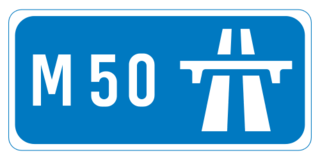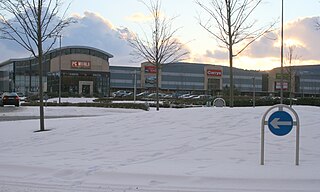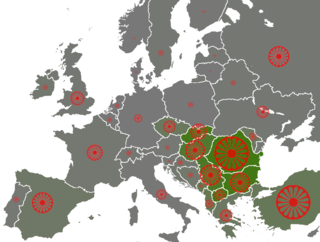Related Research Articles

The Romani, also spelled Romany or Rromani and colloquially known as the Roma, are an ethnic group of Indo-Aryan origin who traditionally lived a nomadic, itinerant lifestyle. Linguistic and genetic evidence suggests that the Romani originated in the Indian subcontinent, in particular the region of present-day Rajasthan. Their subsequent westward migration, possibly in waves, is now believed by historians to have occurred around 1000 CE. Their original name is from the Sanskrit word डोम, ḍoma and means a member of the Dom caste of travelling musicians and dancers. The Roma population moved west into the Ghaznavid Empire and later into the Byzantine Empire. The Roma are thought to have arrived in Europe around the 13th to 14th century. Although they are widely dispersed, their most concentrated populations are located in Bulgaria, Hungary, Romania, Spain, and Turkey.

The Romani Holocaust or the Romani genocide was the planned effort by Nazi Germany and its World War II allies and collaborators to commit ethnic cleansing and eventually genocide against European Roma and Sinti peoples during the Holocaust era.

The Sinti are a subgroup of Romani people. They are found mostly in Germany, France and Italy and Central Europe, numbering some 200,000 people. They were traditionally itinerant, but today only a small percentage of Sinti remain unsettled. In earlier times, they frequently lived on the outskirts of communities.

The M50 motorway is a C-shaped orbital motorway in Dublin and the busiest motorway in Ireland. The current route was built in various sections over the course of 27 years, from 1983 to 2010. It begins at Dublin Port, running northward through the Dublin Port Tunnel and along a portion of the Airport Motorway. It then turns west at its junction with the M1, circling the northern, western and southern suburbs of Dublin, before merging with the M11 at Shankill in South East Dublin. The road forms part of European route E01.

The N11 road is a national primary road in Ireland, running for 129 km (80 mi) along the east side of Ireland from Dublin to Wexford. It passes close to Bray, Greystones, Wicklow, Arklow, Gorey, and Enniscorthy. Beyond Wexford, the route continues to Rosslare as the N25. The road forms part of European route E01. As of July 2019 the N11/M11 is of dual carriageway or motorway standard from Dublin as far as Oilgate in County Wexford.

The N4 road is a national primary road in Ireland, running from Dublin to the northwest of Ireland and Sligo town. The M6 to Galway diverges from this route after Kinnegad, while the N5 to Westport diverges at Longford town. Most sections of the N4 that are motorway-standard are designated the M4 motorway.
Carrickmines Castle is an archaeological site in Carrickmines, County Dublin, in eastern Ireland. The castle was built in the Middle Ages to protect the English-ruled Pale around Dublin. The mostly subsurface ruins lay in the path of the M50 motorway, completed in 2005. Sections of the medieval walls and some sections of the castle's defensive structures were preserved within or under M50 roundabouts.

The Romanichal are a Romani subgroup within the United Kingdom and other parts of the English-speaking world. Most Romanichal speak Angloromani, a mixed language that blends Romani vocabulary with English syntax. Romanichal resident in England, Scotland, and Wales are part of the Gypsy, Roma, and Traveller community.

Roma, traditionally Țigani, constitute one of Romania's largest minorities. According to the 2011 census, their number was 621,573 people or 3.3% of the total population, being the second-largest ethnic minority in Romania after Hungarians. There are different estimates about the size of the total population of people with Romani ancestry in Romania, varying from 4.6 per cent to over 10 percent of the population, because many people of Romani descent do not declare themselves Roma. For example, in 2007 the Council of Europe estimated that approximately 1.85 million Roma lived in Romania, based on an average between the lowest estimate and the highest estimate available at the time. This figure is equivalent to 8.32% of the population.
The Romani people, also referred to as Roma, Sinti, or Kale, depending on the subgroup, are an Indo-Aryan ethnic group that primarily lives in Europe. The Romani may have migrated from what is the modern Indian state of Rajasthan, migrating to the northwest around 250 BC. Their subsequent westward migration, possibly in waves, is now believed to have occurred beginning in about 500 AD. It has also been suggested that emigration from India may have taken place in the context of the raids by Mahmud of Ghazni. As these soldiers were defeated, they were moved west with their families into the Byzantine Empire.

The Romani flag or the flag of the Roma is the international ethnic flag of the Romani people, historically known as "Gypsies", which form a stateless minority in countries across Eurasia, Africa, the Americas, and Australasia. It was approved by the representatives of various Romani communities at the first and second World Romani Congresses (WRC), in 1971 and 1978. The flag consists of a background of blue and green, representing the heavens and earth, respectively; it also contains a 16-spoke red dharmachakra, or cartwheel, in the center. The latter element stands for the itinerant tradition of the Romani people and is also an homage to the flag of India, added to the flag by scholar Weer Rajendra Rishi. It superseded a number of tribal emblems and banners, several of which evoked claims of Romani descent from the Ancient Egyptians.

Anti-Romani sentiment is a form of bigotry which consists of hostility, prejudice, discrimination, racism and xenophobia which is specifically directed at Romani people. Non-Romani itinerant groups in Europe such as the Yenish, Irish and Highland Travellers are frequently given the name "gypsy" and as a result, they are frequently confused with the Romani people. As a result, sentiments which were originally directed at the Romani people are also directed at other traveler groups and they are frequently referred to as "antigypsy" sentiments.

Carrickmines is an outer suburb of Dublin in Dún Laoghaire–Rathdown, Ireland. The area, still semi-rural, was historically on the border of English control and featured a defensive construction, Carrickmines Castle, which became the subject of national controversy during the building of a late stage of Dublin's M50 orbital motorway.

The Romani people have several distinct populations, the largest being the Roma and the Calé, who reached Anatolia and the Balkans in the early 12th century, from a migration out of the Indian subcontinent beginning about 1st century – 2nd century AD. They settled in the areas of present-day Turkey, Greece, Serbia, Romania, Croatia, Moldova, Bulgaria, North Macedonia, Hungary, Albania, Kosovo, Bosnia and Herzegovina, Czech Republic, Slovenia and Slovakia, by order of volume, and Spain. From the Balkans, they migrated throughout Europe and, in the nineteenth and later centuries, to the Americas. The Roma population in the United States is estimated at more than one million.
Romani people in France, generally known in spoken French as gitans, tsiganes or manouches, are an ethnic group that originated in Northern India. The exact number of Romani people in France is unknown; estimates vary from 500,000 to 1,200,000.

In Ireland, the highest category of road is a motorway, indicated by the prefix M followed by a one- or two-digit number. The motorway network consists entirely of motorway-grade dual carriageways and is largely focused upon Dublin. There are also several three-lane motorways, while Ireland's busiest road, the M50, incorporates four-lane, five-lane, and six-lane stretches.

Brian Joseph Lenihan was an Irish Fianna Fáil politician who served as Minister for Finance from 2008 to 2011, Deputy leader of Fianna Fáil from March 2011 to June 2011, Minister for Justice, Equality and Law Reform from 2007 to 2008 and Minister of State for Children from 2002 to 2007. He served as a Teachta Dála (TD) for the Dublin West constituency from 1996 until his death in 2011.
The deportation of Roma migrants from France was subject of intense political debate in France and internationally in 2009 and 2010. After two fatal incidents, President of France Nicolas Sarkozy vowed in July 2010 to evict at least half of the 539 Roma squatted land camps. The Government of France initiated a program to repatriate thousands of Romanian and Bulgarian Roma, as part of the crackdown. Between July and September 2010, at least 51 Roma camps were demolished, and France has repatriated at least 1,230 Roma to Romania and Bulgaria.

Romani Americans are Americans who have full or partial Romani ancestry. It is estimated that there are one million Romani people in the United States. Though the Romani population in the United States has largely assimilated into American society, the largest concentrations are in Southern California, the Pacific Northwest, Southwestern United States, Texas, Louisiana, Florida and the Northeast as well as in cities such as Chicago and St. Louis.

Romani people have been recorded in the United Kingdom since at least the early 16th century. There are estimated to be around 225,000 Romani residing in the UK. This includes the Romanichal, Welsh Kale and a sizeable population of Eastern European Roma, who immigrated into the UK in the late 1990s/early 2000s and after EU expansion in 2004. They are considered part of the Gypsy, Roma and Traveller (GRT) community. Romani people in the UK are predominantly Christian, with 71.8% of English and Welsh Romani identifying as Christian in the 2021 census compared to 46.2% of the wider population.
References
- ↑ "63 Roma leave M50 camp to await flight". RTÉ . 24 July 2007. Retrieved 11 April 2018.
- ↑ "Conflicte interetnice în istoria recentă a României". Descopera.ro (in Romanian). 25 February 2017. Retrieved 8 October 2020.
- 1 2 McDonald, Daniel McLaughlin Henry (28 July 2007). "M50 Gypsies abandon Irish dream". The Observer . ISSN 0029-7712 . Retrieved 8 October 2020.
- ↑ Fleming, Diarmaid (21 July 2007). "Motorway Romas' plea for housing". BBC News . Retrieved 8 October 2020.
- ↑ "Roma teenager lured to her death by Dublin sex predator, say Irish police". Belfast Telegraph . 31 May 2010. ISSN 0307-1235 . Retrieved 8 October 2020.
- ↑ "18/07/07 Crosscare Response to Roma Families on M50". Archdiocese of Dublin . 18 July 2007. Retrieved 8 October 2020.
- ↑ "Roma families removed from M50 roundabout". The Irish Times . 24 July 2007. Retrieved 8 October 2020.
- ↑ Ring, Evelyn (26 July 2007). "Last of Roma abandon M50 camp". Irish Examiner . Retrieved 8 October 2020.